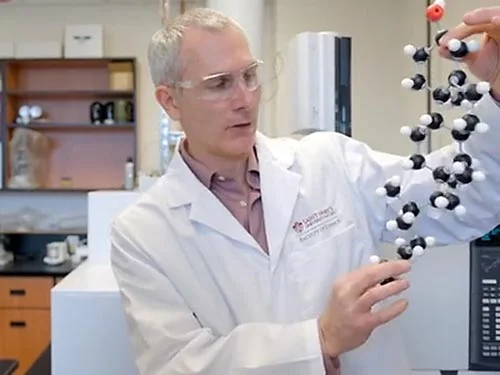Adam MacDonald, NS Department of Energy & Mines, examines a core sample taken during an offshore coring cruise. (Source: Genome Atlantic)
Saint Mary’s University is part of a major new initiative that adds genomics technologies to traditional geoscience with the aim to reduce the risk for oil exploration in Nova Scotia’s offshore.
The $6.5 million project, Validation and Integration of Genomics Solutions for Offshore Oil Exploration in Nova Scotia and Beyond, was announced by the Honourable Kirsty Duncan, Minister of Science and Sport, as one of 20 projects across Canada awarded through Genome Canada’s Genomic Applications Partnership Program (GAPP).
The initiative builds on the work of a previous GAPP project in which genomics data and results were compared with petroleum geochemistry data to paint the clearest picture yet of petroleum deposits in areas of Nova Scotia’s offshore. This new project, involving the same team, will take that work to the next level by delivering high-resolution tools and maps developed with the help of autonomous underwater vehicles (AUVs), advanced ‘omics technologies and machine learning.
“The idea of using genomic (DNA-based) tools to help de-risk offshore oil and gas exploration efforts has transitioned from a ‘what if’ idea not that long ago into a compelling opportunity that has earned the support of this project’s many partners,” said Steve Armstrong, President and CEO of Genome Atlantic. “We are extremely pleased to have the opportunity to work with such a dedicated and talented group committed to establishing Nova Scotia as a leader within this globally competitive sector.”
Project co-lead Dr. Todd Ventura
The project is co-led by Dr. Todd Ventura (Saint Mary’s University), Dr. Casey Hubert (University of Calgary), and Adam MacDonald (Nova Scotia Department of Energy and Mines) and is managed by Genome Atlantic in partnership with Genome Alberta.
“This GAPP is expanding on the microbiological toolkit with the addition of lipidomics,” said Dr. Todd Ventura, Saint Mary’s University. “This may allow us the ability to detect more ancient seepage events that can lead to the discovery of new active petroleum systems in the offshore.”
Project partners include the Nova Scotia Department of Energy and Mines; the Geological Survey of Canada, Natural Resources Canada; Research Nova Scotia; Nova Scotia Offshore Energy Research Association (OERA); Mitacs Canada; Applied Petroleum Technology (APT); the University of Calgary; and Saint Mary’s University.
“De-risking our offshore for exploration is critical for Nova Scotia to remain competitive in a global market,” said Adam MacDonald, NS Department of Energy and Mines. “Adding new tools and building innovative and integrated projects such as this collaboration with the University of Calgary and Saint Mary’s University gains recognition and attention to our quality and capacity to compete. Not only do we de-risk exploration but this project provides environmental baseline information on the benthic life and communities that may be dependent on natural occurrences of hydrocarbon on the seafloor.”
The Province of Nova Scotia’s commitment to the project is part of its $12 million investment in offshore R&D over the next four years.
“For generations, the offshore has paid off for Nova Scotians and it still holds tremendous potential to grow our economy and create jobs across the province, especially in rural areas,” said Nova Scotia Energy and Mines Minister Derek Mombourquette. “By continuing to invest in leading-edge research we will find cleaner and safer ways to look for resources and attract international investment to our shores.”



